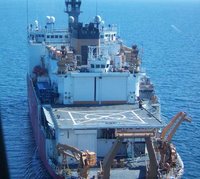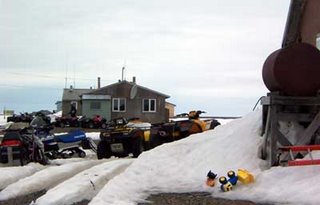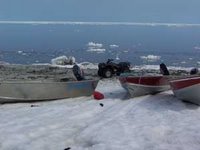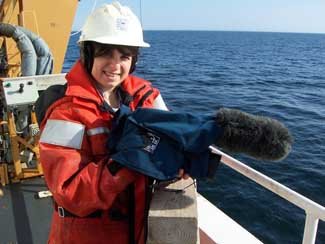Memorial Day in Gambell, AK
It is 1:15 AM in Gambell, Alaska, and the sun is just starting to set. This day has seen a flurry of activity, which is strange since I’m in such a remote part of the world. I knew I would ride the “helo,” or helicopter, from the Healy to Gambell today, but no one could say exactly when. The best estimates were early afternoon. We had been sailing through thick fog south of St. Lawrence Island for two days. This type of fog keeps airplanes and helicopters from flying. But the fog had lifted this morning, leaving behind whispers of high clouds against a pale blue sky.
After five days with the science team aboard the Healy, I’ve learned that plans can change in an instant. Today was no exception. At 8:00 AM Jackie leaned over her homemade donut at breakfast to tell me that I was leaving at 9:00 AM. Her voice was quite calm, but her words were like a loud alarm clock that sent me into high gear. The next hour involved filming a final segment of Jackie with her experiments in the “cold room,” dashing up two decks to pack up my clothes and equipment in my cabin and then sprinting up three levels of icy metal stairs to the bridge for the preflight briefing with Captain Oliver and everyone involved in the helicopter flight. Phew!
Before I knew it, I was wearing a survival suit and helmet, airborne over the Bering Sea. Pilot Jim took us for a fun ride along the south-facing cliffs jutting out over the icy water. Then we headed north across St. Lawrence Island to Gambell. This small village is on the western point of the island. About 35 miles of open water separates Gambell from Russia. The Yupik people here share a common language, Siberian Yupik, with their relatives in Russia. It was a little weird to be on land and seeing the Russian coastline in the same place each time I marveled at it. Aboard the moving Healy, I would see a different landscape each time I looked at the horizon.
The Gambell airport is a landing strip and a hanger. Residents come on their four-wheelers when flights arrive from Nome or Savoonga (on the other side of the island). These ATVs are the local taxis. There are no cars in Gambell. Except the landing strip, there is no pavement in Gambell. The “roads” are tracks in the deep gravel the covers the plateau at the base of a steep slope.
A nice older woman drove up to the helicopter as we were unloading our bags. She offered to help me and Annie Feidt get our gear to the lodge. We didn’t actually have rooms reserved, but somehow we knew we’d fine a place to sleep. The lodge was full of birders who had just flown in for a week of bird watching. Gambell is a prime birding destination, and avid birders are sure to see many exotic species on their seasonal routes.
Luck was with us. We ended up in the lodge’s annex, which is a smaller lodge that happened to be next to a small building housing two US Fish and Wildlife Service volunteers. They are collecting samples from birds shot by local hunters to see if avian flu. Both Annie and I were interested in talking to these ecologists, so our lives just got a little easier.

Mike and Lisa were home when we knocked. They are used to people just dropping by, but they were expecting a local person with news of a recent bird shooting. Mike and Lisa are ecologists from California who are “vacationing” in Gambell. Their job as USFWS volunteers is to meet the townspeople, find out what birds they are hunting and get fecal and feather samples from the felled birds. The samples will then go to Wisconsin lab for testing to see if any of the birds are carrying the H5N1 avian flu virus. Since this form of bird flu has been found throughout most of Asia, it is important to monitor wild birds that fly across the Bering Sea to the US. So far Mike and Lisa have collected about 85 samples, which they keep frozen in a liquid nitrogen container.
A Different Kind of Walrus Sighting
Later today day I hopped on the back of Lisa’s ATV and we zoomed across the pebbly soft terrain to look for interesting birds with local “birder” Jared. We visited the rocky slopes at one end of town. Then we drove across to the marsh. One little bird (I don’t remember the name) came quite close to us before flying away, pooping in mid-air. Lisa desperately searched through the brown grass to find what the bird left behind so she could sample it for testing. No luck.
Around 11:00 PM we four-wheeled-it out to the end of the town to see auklets flock to the rocks high up the steep slope that forms a dramatic backdrop to the flat land below. It was still quite light out. For some reason these birds give off a sweet smell, almost like tangerine. Lisa marvels at the fact that she actually enjoys handling the dead auklets that hunters bring her because the birds smell so good. At the slope, Annie and I both climbed the little trail amid the rocks and lichens to get a better view and sound of the birds. In the distance, I could see the walrus hunting boats heading home for the night. Mike saw hunters shoot a walrus earlier with his spotting scope. We decided to drive down the beach to see what they caught. Along with sea birds, walruses provide much of food that the people of Gambell eat. Groceries are very expensive: a box of oatmeal packets is $8.00. Families in Gambell rely on the sea and sky for their meat. Whales are also an important food stock for the Gambell residents, but they didn't catch one this year. No one is sure, but the lack of a whale may be a result of climate change.
 Dozens of metal fishing boats filled the rocky shore. There were still some snow drifts left near the water, so the boats could easily slide up on the beach. Interspersed between the boats were red splotches of walrus blood where the hunters had disemboweled the small beasts. These were just the young ones. When they kill a walrus cow, the hunters also take the calf because the young ones can't survive alone. The adults are too heavy to bring back whole, so the hunters take out the skull, tusks and meat at sea and leave the carcass on the ice for the sea birds. I stood next to a baby male walrus lying on its back in the snow. Really, it was the skin and meat. All of the other parts had been removed. A woman came over to tell us that every part of the animal would be eaten or used in some way. “That’s the heart,” she said, pointing to a dark red blob. “We eat that. And all that sinew stuff, we eat that, too. Just add a little salt, and it is very tasty.” Next to the entrails was a plastic baggie stuffed full of soft clam bodies. “Those clams are from the walrus’s stomach,” said the woman. “Those are really good. You just clean them off and eat them. Yummy.”
Dozens of metal fishing boats filled the rocky shore. There were still some snow drifts left near the water, so the boats could easily slide up on the beach. Interspersed between the boats were red splotches of walrus blood where the hunters had disemboweled the small beasts. These were just the young ones. When they kill a walrus cow, the hunters also take the calf because the young ones can't survive alone. The adults are too heavy to bring back whole, so the hunters take out the skull, tusks and meat at sea and leave the carcass on the ice for the sea birds. I stood next to a baby male walrus lying on its back in the snow. Really, it was the skin and meat. All of the other parts had been removed. A woman came over to tell us that every part of the animal would be eaten or used in some way. “That’s the heart,” she said, pointing to a dark red blob. “We eat that. And all that sinew stuff, we eat that, too. Just add a little salt, and it is very tasty.” Next to the entrails was a plastic baggie stuffed full of soft clam bodies. “Those clams are from the walrus’s stomach,” said the woman. “Those are really good. You just clean them off and eat them. Yummy.”
We waited until the hunters and their families piled onto their ATVs and headed to their little houses with their prized walruses. Then we drove back to our lodge on the outskirts of town. I decided to trudge across the deep gravel to the main lodge so I could try to upload this post. It was 12:30 AM, and the sun was just beginning to set. Two little girls sat in the gravel watching their puppies, Toto and Angel, chase each other. “What’s your name?” yelled one of the girls to me. That’s an invitation to have a conversation. So I walked over an chatted with them for a while. It was refreshing to see kids out playing without a schedule or supervision. Granted it was after Midnight, but the sun was still up...and so were the kids.
After five days with the science team aboard the Healy, I’ve learned that plans can change in an instant. Today was no exception. At 8:00 AM Jackie leaned over her homemade donut at breakfast to tell me that I was leaving at 9:00 AM. Her voice was quite calm, but her words were like a loud alarm clock that sent me into high gear. The next hour involved filming a final segment of Jackie with her experiments in the “cold room,” dashing up two decks to pack up my clothes and equipment in my cabin and then sprinting up three levels of icy metal stairs to the bridge for the preflight briefing with Captain Oliver and everyone involved in the helicopter flight. Phew!

Before I knew it, I was wearing a survival suit and helmet, airborne over the Bering Sea. Pilot Jim took us for a fun ride along the south-facing cliffs jutting out over the icy water. Then we headed north across St. Lawrence Island to Gambell. This small village is on the western point of the island. About 35 miles of open water separates Gambell from Russia. The Yupik people here share a common language, Siberian Yupik, with their relatives in Russia. It was a little weird to be on land and seeing the Russian coastline in the same place each time I marveled at it. Aboard the moving Healy, I would see a different landscape each time I looked at the horizon.
The Gambell airport is a landing strip and a hanger. Residents come on their four-wheelers when flights arrive from Nome or Savoonga (on the other side of the island). These ATVs are the local taxis. There are no cars in Gambell. Except the landing strip, there is no pavement in Gambell. The “roads” are tracks in the deep gravel the covers the plateau at the base of a steep slope.

A nice older woman drove up to the helicopter as we were unloading our bags. She offered to help me and Annie Feidt get our gear to the lodge. We didn’t actually have rooms reserved, but somehow we knew we’d fine a place to sleep. The lodge was full of birders who had just flown in for a week of bird watching. Gambell is a prime birding destination, and avid birders are sure to see many exotic species on their seasonal routes.
Luck was with us. We ended up in the lodge’s annex, which is a smaller lodge that happened to be next to a small building housing two US Fish and Wildlife Service volunteers. They are collecting samples from birds shot by local hunters to see if avian flu. Both Annie and I were interested in talking to these ecologists, so our lives just got a little easier.

Mike and Lisa were home when we knocked. They are used to people just dropping by, but they were expecting a local person with news of a recent bird shooting. Mike and Lisa are ecologists from California who are “vacationing” in Gambell. Their job as USFWS volunteers is to meet the townspeople, find out what birds they are hunting and get fecal and feather samples from the felled birds. The samples will then go to Wisconsin lab for testing to see if any of the birds are carrying the H5N1 avian flu virus. Since this form of bird flu has been found throughout most of Asia, it is important to monitor wild birds that fly across the Bering Sea to the US. So far Mike and Lisa have collected about 85 samples, which they keep frozen in a liquid nitrogen container.
A Different Kind of Walrus Sighting
Later today day I hopped on the back of Lisa’s ATV and we zoomed across the pebbly soft terrain to look for interesting birds with local “birder” Jared. We visited the rocky slopes at one end of town. Then we drove across to the marsh. One little bird (I don’t remember the name) came quite close to us before flying away, pooping in mid-air. Lisa desperately searched through the brown grass to find what the bird left behind so she could sample it for testing. No luck.
Around 11:00 PM we four-wheeled-it out to the end of the town to see auklets flock to the rocks high up the steep slope that forms a dramatic backdrop to the flat land below. It was still quite light out. For some reason these birds give off a sweet smell, almost like tangerine. Lisa marvels at the fact that she actually enjoys handling the dead auklets that hunters bring her because the birds smell so good. At the slope, Annie and I both climbed the little trail amid the rocks and lichens to get a better view and sound of the birds. In the distance, I could see the walrus hunting boats heading home for the night. Mike saw hunters shoot a walrus earlier with his spotting scope. We decided to drive down the beach to see what they caught. Along with sea birds, walruses provide much of food that the people of Gambell eat. Groceries are very expensive: a box of oatmeal packets is $8.00. Families in Gambell rely on the sea and sky for their meat. Whales are also an important food stock for the Gambell residents, but they didn't catch one this year. No one is sure, but the lack of a whale may be a result of climate change.
 Dozens of metal fishing boats filled the rocky shore. There were still some snow drifts left near the water, so the boats could easily slide up on the beach. Interspersed between the boats were red splotches of walrus blood where the hunters had disemboweled the small beasts. These were just the young ones. When they kill a walrus cow, the hunters also take the calf because the young ones can't survive alone. The adults are too heavy to bring back whole, so the hunters take out the skull, tusks and meat at sea and leave the carcass on the ice for the sea birds. I stood next to a baby male walrus lying on its back in the snow. Really, it was the skin and meat. All of the other parts had been removed. A woman came over to tell us that every part of the animal would be eaten or used in some way. “That’s the heart,” she said, pointing to a dark red blob. “We eat that. And all that sinew stuff, we eat that, too. Just add a little salt, and it is very tasty.” Next to the entrails was a plastic baggie stuffed full of soft clam bodies. “Those clams are from the walrus’s stomach,” said the woman. “Those are really good. You just clean them off and eat them. Yummy.”
Dozens of metal fishing boats filled the rocky shore. There were still some snow drifts left near the water, so the boats could easily slide up on the beach. Interspersed between the boats were red splotches of walrus blood where the hunters had disemboweled the small beasts. These were just the young ones. When they kill a walrus cow, the hunters also take the calf because the young ones can't survive alone. The adults are too heavy to bring back whole, so the hunters take out the skull, tusks and meat at sea and leave the carcass on the ice for the sea birds. I stood next to a baby male walrus lying on its back in the snow. Really, it was the skin and meat. All of the other parts had been removed. A woman came over to tell us that every part of the animal would be eaten or used in some way. “That’s the heart,” she said, pointing to a dark red blob. “We eat that. And all that sinew stuff, we eat that, too. Just add a little salt, and it is very tasty.” Next to the entrails was a plastic baggie stuffed full of soft clam bodies. “Those clams are from the walrus’s stomach,” said the woman. “Those are really good. You just clean them off and eat them. Yummy.”We waited until the hunters and their families piled onto their ATVs and headed to their little houses with their prized walruses. Then we drove back to our lodge on the outskirts of town. I decided to trudge across the deep gravel to the main lodge so I could try to upload this post. It was 12:30 AM, and the sun was just beginning to set. Two little girls sat in the gravel watching their puppies, Toto and Angel, chase each other. “What’s your name?” yelled one of the girls to me. That’s an invitation to have a conversation. So I walked over an chatted with them for a while. It was refreshing to see kids out playing without a schedule or supervision. Granted it was after Midnight, but the sun was still up...and so were the kids.


<< Home